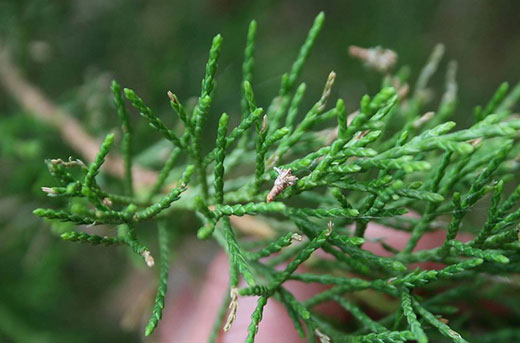
June is a good time to watch for and, if necessary, apply insecticide to manage destructive bagworms. | Download this photo.
Hiding in plain sight: Now’s the time to control bagworms
June is prime time to watch for and control destructive pest
June 4, 2020
MANHATTAN, Kan. – They’re masters of hiding in plain sight, those woody-looking bags that hang from evergreens and other broadleaf plants and shrubs this time of year. But bagworms can be destructive to their host plants, so now’s the time to scout your trees and shrubs and take steps to manage them, according to a Kansas State University entomologist.
“Although the cool weather we experienced this spring slowed development, and consequently larvae hatching from eggs, bagworm caterpillars will eventually be present throughout Kansas, feeding on broadleaf and evergreen trees and shrubs,” said Raymond Cloyd, entomologist with K-State Research and Extension. “So, be prepared to act against bagworms once they are observed on plants.”
Bagworms are primarily a pest of conifers, those trees that bear cones and have needle-like leaves, such as pines, redcedar and junipers. They also sometimes feed on other plants, including broadleafs such as rose, honey locust, hackberry, and flowering plum.
Cloyd said it is important to apply insecticides when bagworms are less than one-fourth inch long to maximize effectiveness of insecticide applications and reduce plant damage.
Several insecticides are labeled for use against bagworms, including those with the following active ingredients: acephate, Bacillus thuringiensis subspecies kurstaki, cyfluthrin, lambda-cyhalothrin, trichlorfon, indoxacarb, chlorantraniliprole, and spinosad, he said. Most of these active ingredients are commercially available and sold under various trade names or as generic products, although some may not be directly available to homeowners.
Managing this insect pest requires some persistence by homeowners, Cloyd said, adding that applying insecticides must happen early and frequently enough to kill the highly susceptible young caterpillars feeding on plant foliage.
Frequent applications are essential because the larvae do not hatch from eggs simultaneously, but rather hatch over time depending on temperature. In addition, young bagworms can 'blow in' (called ‘ballooning’) from neighboring plants on silken threads. If left unchecked, they can cause significant damage and ruin the aesthetic quality of plants, and in some cases, kill plants. Newly transplanted small evergreens are the most susceptible, because evergreens do not usually produce another flush of growth after being fed upon or defoliated by bagworms.
“Applying insecticides weekly for four to five weeks when bagworms are first noticed will reduce problems with bagworms later in the year,” Cloyd said. The bacterium, Btkurstaki, which is sold under various trade names, is only active on young caterpillars and must be consumed or ingested to be effective, so thorough coverage of all plant parts and frequent applications are required.
The insecticide degrades in sunlight and rainfall, which reduces its residual activity, Cloyd said.
Spinosad is the active ingredient in several homeowner products, including Natural Guard Spinosad; Captain Jack’s DeadBug Brew; and Monterey Garden Insect Spray. Although it works by contact, the best control is when bagworms ingest it.
Cyfluthrin (BioAdvanced Vegetable & Garden Insect Spray), lambda-cyhalothrin (Spectracide Triazicide, Bonide Caterpillar Killer), trichlorfon, chlorantraniliprole, and indoxacarb can also be used against young caterpillars.
Finally, Cloyd said, it’s important to get thorough coverage of all plant parts when treating with an insecticide, especially the tops of trees and shrubs where bagworms commonly start feeding.
Questions about managing bagworms can be directed to your county or district horticulture agent. In addition, a new publication, Bagworm: Insect Pest of Trees and Shrubs is available free online.
Cloyd and his counterparts in K-State’s Department of Horticulture and Natural Resources produce a weekly Horticulture Newsletter with tips for keeping yards healthy year-round. The newsletter is available to view online or can be delivered by email each week.
Interested persons can also send entomology-related questions to Cloyd at rcloyd@ksu.edu.

